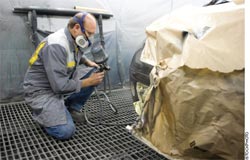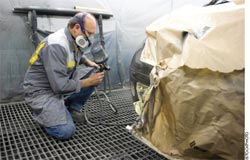
Putting the Squeeze on Methylene Chloride Emissions
A new clean air rule revs up training for auto refinishers.
 The U.S. Environmental Protection
Agency has released its final rule on
emissions from auto refinishing
operations. As a result, shops should
expect to ramp up the time they spend on
recordkeeping and training. The rule
affects “area sources” of emissions; that
is, those operations whose potential
emissions are less than 10 tons a year of a
single hazardous air pollutant or 25 tons
per year of a combination of pollutants.
Operations involving paint stripping,
surface coating of motor vehicles and
mobile equipment, and miscellaneous
surface-coating operations are subject to
the new regulation. This includes those
who refinish autos or coat plastic parts
and products.
The U.S. Environmental Protection
Agency has released its final rule on
emissions from auto refinishing
operations. As a result, shops should
expect to ramp up the time they spend on
recordkeeping and training. The rule
affects “area sources” of emissions; that
is, those operations whose potential
emissions are less than 10 tons a year of a
single hazardous air pollutant or 25 tons
per year of a combination of pollutants.
Operations involving paint stripping,
surface coating of motor vehicles and
mobile equipment, and miscellaneous
surface-coating operations are subject to
the new regulation. This includes those
who refinish autos or coat plastic parts
and products.
The goal is to reduce hazardous air
pollutants that affect public health in
urban areas by tightening control over
some of the smaller emitters. In other
words, to regulate the many smaller businesses
that, on their own, perhaps do not
significantly affect the environment but,
when taken together with other smaller
businesses, do have a significant impact.
The rule does not apply to anyone who
refinishes two or fewer vehicles per year,
provided he does not receive any compensation.
While the new rule is not as
restrictive as some had previously feared,
it does spell out some significant and specific
requirements regarding how workers
are trained, what they’re trained in, what
type of equipment they use, and how businesses
monitor and record emissions and
emission control. Existing operations have
three years to implement the changes,
while new businesses have to be in compliance
when they start up.
More Specific Rules
for Coating Operations
Because EPA issued the rule, it is intended
primarily to safeguard the environment
rather than individual workers’ safety.
That said, however, the safety of individual
workers is included in the details of
the regulation. It stands to reason that if
shops curb environmental emissions, in
addition to improving public health and
safety, such action also will improve the
health and safety of the people closest to
the source of the emissions—the workers.
In some cases, EPA has left decisions
on how to go about reducing emissions up
to the individual companies or operators,
saying they know their businesses best.
For example, paint-stripping operations
that use more than a ton of methylene
chloride annually must have a written plan
to reduce the emissions, and the plan must
address what the companies are doing to
properly store and dispose of materials
containing methylene chloride. The EPA
is not specific on what the plan might
entail, only that it must include practices
and policies that minimize methylene
chloride emissions and optimize stripper
application. Those operations that use less
than a ton of methylene chloride-containing
stripper also must implement
practices to cut emissions, and their
records have to back that up.
The guidelines get more specific when
it comes to what’s required of surfacecoating
operations, in terms of both
equipment and training. On training, operators must ensure that their painters
who use hand-held devices have been
trained in techniques that minimize overspray
as well as in techniques to safety
select and clean spray guns. Guns can’t be
cleaned with an atomized solvent, for
example, but can be hand-cleaned as long
as the spent solvent is captured and properly
disposed of. Training certification is
required, and workers must take a
refresher course at least once every five
years to keep their certification. Spray
painters who have been trained in such
techniques in the past five years can use
that certification to demonstrate compliance
but still must have the refresher
course at the appropriate (five-year)
interval. It’s important to note that
painters who use brushes or rollers do not
need the training. It’s also important to
note that EPA has given employers flexibility
in terms of whether they want to
provide the training in house or send their
workers to another site or program.
Equipment specifications for coating
companies are many, covering everything
from the type of spray gun used to the
type of spray booth that is used, to the
ventilation and filtering requirements.
Reporting Requirements
Regardless of whether businesses have
been around a while or are new, all companies
that are sources of these emissions
must be on record with EPA or the state
or local air pollution control agency. They
must submit a notification that they’re
aware of the rule and are or will be in
compliance by the target date.
Additionally, businesses must keep
complete and accurate records on
training, filter efficiency, spray gun efficiency,
methylene chloride annual usage,
which paint strippers containing methylene
chloride are used, notifications,
reports, and compliance activities. EPA
estimates the average shop will spend
about six and a half hours each year on
maintaining records once the full-compliance
period is reached.
Good records will be the shops’ first
line of defense and, for EPA, the first line
of offense to ensure the rule is being followed.
Shops should expect a fair amount
of outreach early on as the government
works to let businesses know about the
new rule. However, after about a year of
this, businesses will find less tolerance for
procrastination or violations.
EPA Forecasts Net Savings for Industry
During the public comment period, some
industry representatives voiced objections
about the costs of the training, the equipment,
and the reporting requirements.
In every case, however,
EPA says the new rule will in fact
result in a cost savings for most businesses.
In terms of training, EPA estimates costs
at $1,000 per painter but goes on to say it
believes that estimate is inflated for multiple
reasons. It notes that many facilities already
require training for their painters—much of
which is provided by paint companies to
help reduce warranty claims—and the new
rule doesn’t impose additional training
costs. It also says that, according to industry
data, properly trained painters can cut the
amount of coating used by about 20 percent
per job, thereby offsetting any increased
training expenditure.
On equipment costs, EPA says outlays
for the new, compliant spray booths, spray
guns, and filters will be offset by increased
efficiencies in both labor and materials.
And on reporting costs, EPA again says
the cost is too small to be of consequence,
estimating an annual cost of $11 for some
stripping operations.
It’s worth pointing out that the final
rule does a good job of balancing environmental
concerns with industry needs and
flexibility. Revisions have narrowed the
focus, extended the compliance timeline,
and left many decisions up to businesses in
terms of what management practices they
institute to comply with regulations.
Revisions also reflect industry comments
on equipment specifications, with
EPA relaxing some of its earlier requirements
to increase flexibility while still
staying true to the intent and the purpose
of the rule. As an example, EPA originally
required the use of polyester fiberglass filters.
Commenters demonstrated that nonpolyester
fiberglass filters can obtain the
same or better efficiency, often at a lower
cost, and so EPA revised the rule to say that
any filter can be used as long as it meets an
efficiency standard of 98 percent or better.
Timeline Allows Phase-in
Although existing businesses have three
years to comply fully with the new regulations,
certain newer companies have just
180 days from their start-up date. As of
the final date of the rule, all new businesses
must comply upon start-up.
With a three-year timetable for full
compliance, existing businesses should use
this time wisely and work to phase in
implementation. This is a way to spread
costs, maximize training schedules, finetune
methodology, streamline recordkeeping,
and leverage efficiency standards.
This also would be a good time to talk
with suppliers about what impact the rule
will have on equipment cost, efficiency,
and availability because they, too, will
have to make adjustments in response to
this rule.
This article originally appeared in the May 2008 issue of Occupational Health & Safety.